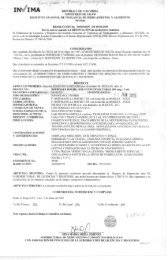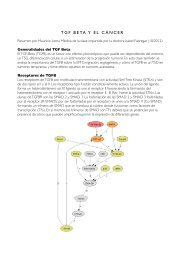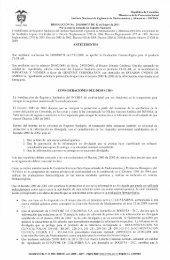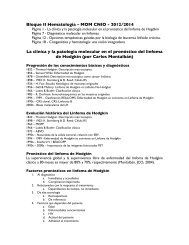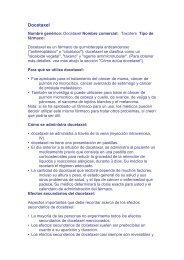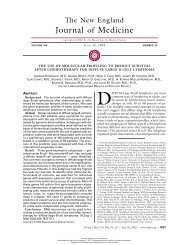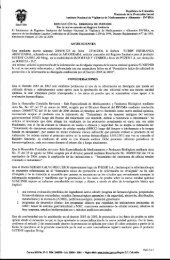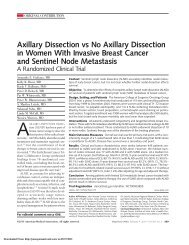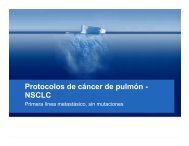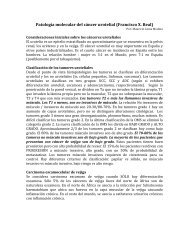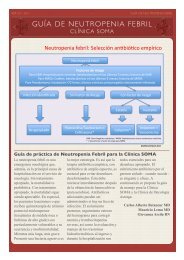Articles Adjuvant vinorelbine plus cisplatin versus observation in ...
Articles Adjuvant vinorelbine plus cisplatin versus observation in ...
Articles Adjuvant vinorelbine plus cisplatin versus observation in ...
Create successful ePaper yourself
Turn your PDF publications into a flip-book with our unique Google optimized e-Paper software.
<strong>Articles</strong><strong>Adjuvant</strong> <strong>v<strong>in</strong>orelb<strong>in</strong>e</strong> <strong>plus</strong> <strong>cisplat<strong>in</strong></strong> <strong>versus</strong> <strong>observation</strong> <strong>in</strong>patients with completely resected stage IB–IIIA non-smallcelllung cancer (<strong>Adjuvant</strong> Navelb<strong>in</strong>e International TrialistAssociation [ANITA]): a randomised controlled trialJean-Yves Douillard, Rafael Rosell, Mario De Lena, Francesco Carpagnano, Rodryg Ramlau, Jose Luis Gonzáles-Larriba, Tomasz Grodzki,Jose Rodrigues Pereira, Ala<strong>in</strong> Le Groumellec, Vito Lorusso, Claude Clary, Antonio J Torres, Jabrail Dahabreh, Pierre-Jean Souquet, Julio Astudillo,Pierre Fournel, Angel Artal-Cortes, Jacek Jassem, Leona Koubkova, Patricia His, Marcello Riggi, Patrick HurteloupSummaryBackground Whether adjuvant chemotherapy improves survival of patients with non-small-cell lung cancer (NSCLC)is not known. We aimed to compare the effect of adjuvant <strong>v<strong>in</strong>orelb<strong>in</strong>e</strong> <strong>plus</strong> <strong>cisplat<strong>in</strong></strong> <strong>versus</strong> <strong>observation</strong> on survival <strong>in</strong>patients with completely resected NSCLC.Methods 840 patients with stage IB–IIIA NSCLC from 101 centres <strong>in</strong> 14 countries were randomly assigned to<strong>observation</strong> (n=433) or to 30 mg/m 2 <strong>v<strong>in</strong>orelb<strong>in</strong>e</strong> <strong>plus</strong> 100 mg/m 2 <strong>cisplat<strong>in</strong></strong> (n=407). Postoperative radiotherapy was notmandatory and was undertaken accord<strong>in</strong>g to every centre’s policy. The primary endpo<strong>in</strong>t was overall survival. Analysiswas by <strong>in</strong>tention to treat. This trial is registered as an International Standard Randomised Controlled Trial, numberISRCTN95053737.F<strong>in</strong>d<strong>in</strong>gs 367 patients <strong>in</strong> the chemotherapy group and 431 <strong>in</strong> the control group received their assigned treatment.301 (36%) patients had stage IB disease, 203 (24%) had stage II disease, and 325 (39%) had stage IIIA disease.Tolerance to chemotherapy ma<strong>in</strong>ly <strong>in</strong>cluded neutropenia <strong>in</strong> 335 (92%) patients and febrile neutropenia <strong>in</strong> 34 (9%);seven (2%) toxic deaths were also recorded. Compliance was greater with <strong>cisplat<strong>in</strong></strong> than with <strong>v<strong>in</strong>orelb<strong>in</strong>e</strong> (mediandose <strong>in</strong>tensity 89% [range 17–108] vs 59% [17–100]). After a median follow-up of 76 months (range 43–116), mediansurvival was 65·7 months (95% CI 47·9–88·5) <strong>in</strong> the chemotherapy group and 43·7 (35·7–52·3) months <strong>in</strong> the<strong>observation</strong> group. Adjusted risk for death was significantly reduced <strong>in</strong> patients assigned chemotherapy comparedwith controls (hazard ratio 0·80 [95% CI 0·66–0·96]; p=0·017). Overall survival at 5 years with chemotherapyimproved by 8·6%, which was ma<strong>in</strong>ta<strong>in</strong>ed at 7 years (8·4%).Interpretation <strong>Adjuvant</strong> <strong>v<strong>in</strong>orelb<strong>in</strong>e</strong> <strong>plus</strong> <strong>cisplat<strong>in</strong></strong> extends survival <strong>in</strong> patients with completely resected NSCLC, betterdef<strong>in</strong><strong>in</strong>g <strong>in</strong>dication of adjuvant chemotherapy.IntroductionThe International Agency for Research on Cancer reported1·2 million cases of lung cancer worldwide <strong>in</strong> 2000, with1·1 million deaths. 1 Despite surgery, about 40% of patientswith stage I non-small-cell lung cancer (NSCLC), 60% ofpatients with stage II disease, and 75% of patients withstage IIIA disease die with<strong>in</strong> 5 years. 2,3 In 1995, a metaanalysis4 showed a non-significant 5% survival advantageat 5 years with <strong>cisplat<strong>in</strong></strong>-based adjuvant chemotherapy <strong>in</strong>resected NSCLC compared with surgery alone. Thisf<strong>in</strong>d<strong>in</strong>g prompted the plann<strong>in</strong>g of additional randomisedtrials. 5 The International <strong>Adjuvant</strong> Lung Trial (IALT) 6showed a significant 4% benefit at 5 years for <strong>cisplat<strong>in</strong></strong>basedchemotherapy <strong>in</strong> comb<strong>in</strong>ation with various agentsafter curative surgery <strong>in</strong> stage I–III NSCLC. The <strong>Adjuvant</strong>Lung Cancer Project Italy (ALPI) 7 did not f<strong>in</strong>d a survivalbenefit for chemotherapy, although the study used a toxicregimen. Subset analysis by stage showed that the hazardratio of death was 0·80 (95% CI 0·60–1·06) for stage II<strong>versus</strong> 0·97 (0·71–1·33) and 1·06 (0·82–1·38) for stages Iand III, respectively. The Cancer and Leukemia Group B(CALGB) 9633 study 8 reported a 12% reduction <strong>in</strong> mortalityat 4 years with adjuvant carboplat<strong>in</strong> <strong>plus</strong> paclitaxel <strong>in</strong>stage IB NSCLC, and an update 8 with extended follow-up(54 vs 34 months) showed that improvement <strong>in</strong> survivalwas no longer significant. The National Cancer Instituteof Canada JBR.10 trial 9 showed a 15% improvement <strong>in</strong>overall survival for stage IB–II NSCLC treated with<strong>v<strong>in</strong>orelb<strong>in</strong>e</strong> <strong>plus</strong> <strong>cisplat<strong>in</strong></strong>. The subset analysis by stageshowed a greater benefit at 5 years for stage II (20%) thanfor stage I (7%); at 6 years, the benefit for stage Idisappeared, and survival was greater <strong>in</strong> the control group.In 1994, the <strong>Adjuvant</strong> Navelb<strong>in</strong>e International TrialistAssociation (ANITA) <strong>in</strong>itiated a randomised phase III trial<strong>in</strong> patients with completely resected stage IB, II, and IIIANSCLC, to assess the survival benefit of adjuvant<strong>v<strong>in</strong>orelb<strong>in</strong>e</strong> <strong>plus</strong> <strong>cisplat<strong>in</strong></strong> <strong>versus</strong> control.MethodsPatientsThis open-label study was done <strong>in</strong> 101 centres <strong>in</strong>14 countries. It was approved by the ethics committee ofLancet Oncol 2006; 7: 719–27Published Onl<strong>in</strong>eAugust 16, 2006DOI:10.1016/S1470-2045(06)70804-XSee Reflection and Reactionpage 701Centre René Gauducheau,Nantes, France(Prof J-Y Douillard MD); CatalanInstitute of Oncology, HospitalGermans Trias i Pujol,Badalona, Spa<strong>in</strong>(Prof R Rosell MD); IRCCSOncologico, Bari, Italy(M De Lena MD); Ospedale SanPaolo, Bari, Italy(F Carpagnano MD); Chorob PlucI Gruzlicy, Poznan, Poland(R Ramlau MD); Hospital SanCarlos, Madrid, Spa<strong>in</strong>(J L Gonzáles-Larriba MD);Regional Hospital for LungDisease, Thoracic Surgery,Szczec<strong>in</strong>, Poland(T Grodzki MD); Instituto doCancer Arnaldo Vieira deCarvalho, Sao Paulo, Brazil(J R Pereira MD); CentreHospitalier P Chubert, Vannes,France (A Le Groumellec MD);Ospedale “A Cardarelli”, Naples,Italy (Prof V Lorusso MD);Centre Hospitalier RegionalPasteur, Nice, France(C Clary MD); Hospital SanCarlos, Madrid, Spa<strong>in</strong>(A J Torres MD); SismanoglioGeneral Hospital, Athens,Greece (J Dahabreh MD); CentreHospitalier Lyon Sud, Pierre-Benite, France(P-J Souquet MD); HospitalGermans Trias i Pujol,Badalona, Spa<strong>in</strong>(J Astudillo MD); Hôpital Nord,Sa<strong>in</strong>t-Etienne, France(P Fournel MD); Hospital MiguelServet, Zaragoza, Spa<strong>in</strong>(A Artal-Cortes MD); Academyof Medic<strong>in</strong>e, Gdansk, Poland(Prof J Jassem MD); Nem Kladno,Kladno, Czech Republichttp://oncology.thelancet.com Vol 7 September 2006 719
<strong>Articles</strong>(L Koubkova MD); Institut deRecherche Pierre Fabre, Paris,France (P His, M Riggi MD,P Hurteloup MD)Correspondence to:Dr Jean-Yves Douillard,Department of Medical Oncology,Centre René Gauducheau,University of Nantes,44805 St Herbla<strong>in</strong>, Nantes, Francejy-douillard@nantes.fnclcc.fr9 <strong>in</strong>eligible patients:1 bronchoalveolar carc<strong>in</strong>oma2 stage IIIB– IV disease3 T1N0M0 status3 not completely resected407 assigned to chemotherapy840 patients randomised39 patients did not start treatment:21 refused chemotherapy3 died before treatment8 had postsurgical complicationsor other serious adverse event3 began radiotherapy beforechemotherapy2 lost to follow-up1 had stage IV diseasesubequently diagnosed1 was not treated by mistake433 assigned to <strong>observation</strong>18 <strong>in</strong>eligible patients:6 bronchoalveolar carc<strong>in</strong>oma3 stage IIIB–IV disease3 T1N0M0 status4 not completely resected2 previous primary tumours2 treated withchemotherapy(violation)368 patients received chemotherapy(of whom 1 received <strong>v<strong>in</strong>orelb<strong>in</strong>e</strong> only)431 patients given <strong>observation</strong>9 died before end of chemotherapy57 stopped because of toxic effects79 refused further treatment21 stopped for other reason202 received the planned four cycles88 received radiotherapy280 did not receive radiotherapy144 received radiotherapy289 did not receive radiotherapy407 <strong>in</strong>cluded <strong>in</strong> analysis 433 <strong>in</strong>cluded <strong>in</strong> analysisFigure 1: ANITA trial profileChemotherapy refers to four cycles of <strong>in</strong>travenous <strong>v<strong>in</strong>orelb<strong>in</strong>e</strong> and <strong>cisplat<strong>in</strong></strong>.every centre and undertaken accord<strong>in</strong>g to the Declarationof Hels<strong>in</strong>ki. Written <strong>in</strong>formed consent was obta<strong>in</strong>ed forall patients. Eligibility criteria <strong>in</strong>cluded: histologicallyproven primary NSCLC (apart from bronchoalveolarcarc<strong>in</strong>oma) after exam<strong>in</strong>ation of the resected tumour by<strong>in</strong>stitution pathologist, and pathological TNM (tumour,node, metastasis) stag<strong>in</strong>g. Patients were eligible if theyhad stage I (T2N0 only), stage II, and stage IIIA NSCLCaccord<strong>in</strong>g to the 1986 TNM classification; completeresection of the primary tumour (all marg<strong>in</strong>s free ofdisease: R0); age 18–75 years; WHO performance status 2or less; and adequate biological functions. Patients with ahistory of concurrent malignant disease (apart fromadequately treated non-melanoma sk<strong>in</strong> cancer or <strong>in</strong>-situcervical cancer) or other previous primary tumours wereexcluded.ProceduresPatients stratified by centre, stage, and histology(squamous vs other) were randomly assigned to<strong>v<strong>in</strong>orelb<strong>in</strong>e</strong> <strong>plus</strong> <strong>cisplat<strong>in</strong></strong> or to <strong>observation</strong> (control).Patients <strong>in</strong> the chemotherapy group received 30 mg/m 2<strong>v<strong>in</strong>orelb<strong>in</strong>e</strong> (Navelb<strong>in</strong>e ® ; Pierre Fabre MédicamentProduction, Pau, France) on days 1, 8, 15, and 22 (cyclesrepeated every 4 weeks) for a maximum of 16 doses; and100 mg/m 2 <strong>cisplat<strong>in</strong></strong> on days 1, 29, 57, and 85 (Cisplatylcommercially available from SANOFI Paris, France).Patients <strong>in</strong> both groups received the same assessmentswith respect to cl<strong>in</strong>ical exam<strong>in</strong>ation, haematologicalanalysis, and tumour <strong>in</strong>vestigation.Postoperative radiotherapy was not mandatory orrandomised <strong>in</strong> the ANITA trial. The procedure wasoptional, was left to the decision of every participat<strong>in</strong>gcentre, and was to be decided before patients were<strong>in</strong>cluded <strong>in</strong>to the trial. Radiotherapy was eventuallyrecommended for patients with node-positive disease, atdoses rang<strong>in</strong>g from 45 to 60 Gy, 2 Gy per fraction,five fractions a week, which was to be started 2 weeksafter the end of chemotherapy or with<strong>in</strong> 2 weeks afterrandomisation <strong>in</strong> the control group.720 http://oncology.thelancet.com Vol 7 September 2006
<strong>Articles</strong>Patients were registered and randomised by theBiometric Department of the Institut de Recherche PierreFabre (IRPF, Paris, France), which was also responsiblefor the statistical analysis. Treatment was allocated throughlist<strong>in</strong>gs issued from computer by blocks of four patientsand then faxed to the centre, not masked. Eligibility criteriawere checked directly on the registration form faxed bythe <strong>in</strong>vestigator to IRPF with<strong>in</strong> 42 days of surgery.Patients were followed up every 3 months dur<strong>in</strong>g thefirst 2 years, and then every 6 months until death.Investigators assessed local or distant relapse cl<strong>in</strong>icallyor with conventional imag<strong>in</strong>g consist<strong>in</strong>g of chestradiographs, abdom<strong>in</strong>al ultrasonography, bone scans, CTscans, and MRI. Second primary lung cancer was notregarded as a relapse. Local relapse was def<strong>in</strong>ed asipsilateral mediast<strong>in</strong>al relapse, and all other relapseswere regarded as distant relapses, <strong>in</strong>clud<strong>in</strong>g those <strong>in</strong> thecontralateral mediast<strong>in</strong>um or <strong>in</strong> other organs.All study centres were monitored. Dur<strong>in</strong>g visits, studyprocedures, protocol compliance, and <strong>in</strong>formed consentprocedures were reviewed. An <strong>in</strong>dependent datamonitor<strong>in</strong>g committee was appo<strong>in</strong>ted.The primary endpo<strong>in</strong>t was to compare overall survival <strong>in</strong>the two groups. Secondary endpo<strong>in</strong>ts were disease-freesurvival and safety. Overall survival was def<strong>in</strong>ed as thetime elapsed from the date of randomisation to death fromany cause or to last follow-up. Patients who were alive atthe cutoff date or lost to follow-up were censored at thedate of last contact. We def<strong>in</strong>ed disease-free survival as thetime elapsed from the date of randomisation to relapse orto death from any cause. Patients without relapse at cutoffwere censored at the date of last contact. Maximum WHOgrade (or severity) was reported by cycle and by patient forhaematological and non-haematological toxic effects.Statistical analysisBy assum<strong>in</strong>g a 2-year survival of 30% <strong>in</strong> the controlgroup, an absolute improvement of 10% <strong>in</strong>dicat<strong>in</strong>g abenefit of adjuvant chemotherapy, a power of 90%, and aone-sided type I error of 5%, we calculated that 466 deathswere needed by us<strong>in</strong>g a 1:1 randomisation procedure anda log-rank test to compare the groups. With theseassumptions, an accrual period of 2 years, 1 additionalyear of follow-up, and the accommodation for an anticipated10% loss to follow-up, the planned sample sizefor the study was 400 patients per treatment group.Time-dependent variables were described by Kaplan-Meier curves and life tables by treatment group. Overallsurvival and disease-free survival were compared by astratified log-rank test. We did a multivariate analysis toidentify the prognostic factors for overall survival. Allvariables reach<strong>in</strong>g a significant level of 10% <strong>in</strong> univariateanalyses were tested <strong>in</strong> a Cox proportional hazards model.Subgroup analyses were not planned; however, exploratoryanalyses were undertaken to generate hypotheses.We did an <strong>in</strong>terim analysis of safety at 6 months, at12 months, and when 600 patients had been enrolled, toChemotherapy (n=407) Observation (n=433)Age (years)Median (range) 59 (32–75) 59 (18–75)
<strong>Articles</strong>V<strong>in</strong>orelb<strong>in</strong>e (n=407) Cisplat<strong>in</strong> (n=407)Patients never treated 39 40Patients who completed cycles (% of treated patients)Cycle 1 368 (90%) 367 (90%)Cycle 2 296 (73%) 295 (72%)Cycle 3 248 (61%) 247 (61%)Cycle 4 202 (50%) 201 (49%)Planned dose (mg/m 2 ) 480 400Cumulative dose (mg/m 2 ) 270 (20–515) 304 (50–418)Dose <strong>in</strong>tensity (mg/m 2 per week) 18 (5–30) 22 (4–27)Relative dose <strong>in</strong>tensity (%) 59% (17–100) 89% (17–108)Number of doses 10 (1–17) 4 (1–4)Data are number of patients (%) or median (range) unless stated otherwise.Table 2: Chemotherapy compliancehandled all questions regard<strong>in</strong>g the management of thestudy. The correspond<strong>in</strong>g author had full access to all thedata <strong>in</strong> the study and had f<strong>in</strong>al responsibility for thedecision to submit for publication.ResultsFrom December, 1994, to December, 2000, 840 patientswere enrolled <strong>in</strong> the trial: 407 were assigned tochemotherapy and 433 to <strong>observation</strong> (figure 1). OnAug 1, 2004, median potential follow-up was 76 months(range 43–113) <strong>in</strong> the chemotherapy group and 77 months(43–116) <strong>in</strong> the <strong>observation</strong> group.Table 1 shows the patients’ characteristics. Overall,486 (58%) patients had a lobectomy and 310 (37%) apneumonectomy; 325 (39%) had postoperative stage IIIAdisease, 203 (24%) had stage II disease, and 301 (36%)had stage I (T2N0) disease. Biological variables, medicaland surgical history, tobacco and alcohol consumption,and cl<strong>in</strong>ical characteristics at basel<strong>in</strong>e did not differbetween the two groups.In the chemotherapy group, 368 (90%) patients received<strong>v<strong>in</strong>orelb<strong>in</strong>e</strong> and 367 concurrently received <strong>cisplat<strong>in</strong></strong>(figure 1). Of these patients, 141 (38%) patients receivedmore than 66% of the total planned dose of <strong>v<strong>in</strong>orelb<strong>in</strong>e</strong>and 233 (63%) received more than 66% of the totalplanned dose of <strong>cisplat<strong>in</strong></strong>; 202 (50%) patients completedthe planned four cycles (table 2). Compliance tochemotherapy showed no difference accord<strong>in</strong>g to type ofsurgery. Fewer patients undergo<strong>in</strong>g pneumonectomyreceived more than 66% of the planned chemotherapydoses than those undergo<strong>in</strong>g lobectomy (49 [35%] vs85 [40%] for <strong>v<strong>in</strong>orelb<strong>in</strong>e</strong>, p=0·35; 83 [59%] vs 142 [67%]for <strong>cisplat<strong>in</strong></strong>, p=0·16).The most frequent haematological grade 3–4 toxiceffects <strong>in</strong> the chemotherapy group were neutropenia,anaemia, and febrile neutropenia. Other common nonhaematologicaltoxic effects <strong>in</strong>cluded asthenia, nausea orvomit<strong>in</strong>g, anorexia, and <strong>in</strong>fection (table 3). Overall,458 patients died dur<strong>in</strong>g the study or dur<strong>in</strong>g follow-up tothe cutoff date (206 chemotherapy, 252 <strong>observation</strong>).36 of these patients died with<strong>in</strong> 20 weeks afterrandomisation: 16 <strong>in</strong> the chemotherapy group, <strong>in</strong>clud<strong>in</strong>gseven (2%) treatment-related deaths; and 20 deaths <strong>in</strong> the<strong>observation</strong> group. Treatment-related fatal toxic effects<strong>in</strong>cluded four patients with septic shock, one withpneumonia, one with cardiac arrest, and one with renalfailure <strong>in</strong> the chemotherapy group, compared with onewith pneumonia, two with cardiac failure, and one withlethal haemoptysis <strong>in</strong> the <strong>observation</strong> group.At the time of analysis (Aug 1, 2004), 201 (49%) patients<strong>in</strong> the chemotherapy group and 181 (42%) <strong>in</strong> the<strong>observation</strong> group were still alive. Median survival was65·7 months (95% CI 47·9–88·5) for patients assignedchemotherapy and 43·7 months (35·7–52·3) for controls(hazard ratio 0·80 [0·66–0·96], p=0·017; figure 2A).The absolute overall survival benefit for patients assignedchemotherapy compared with controls was 2·8% atChemotherapyObservationWHO grade >0 WHO grade 3–4 WHO grade >0 WHO grade 3–4Neutropenia 335 (92%) 308 (85%) 13 (4%) 1 (
<strong>Articles</strong>ASurvival (%)Number at riskObservationChemotherapyBSurvival (%)100Number at riskObservationChemotherapy7550250100755025Overall survivalp=0·017ObservationChemotherapy433 293 211 119 65 17407 288 228 144 63 1800Disease-free survivalp=0·00220 40 60 80 100Time after randomisation (months)433 217 160 95 50 15407 239 191 130 57 16Figure 2: Disease-free survival and overall survival1 year, 4·7% at 2 years, 8·6% at 5 years, and 8·4% at7 years. In the univariate analysis, we identified ageyounger than 55 years, performance status 0, type ofsurgery, no radiotherapy, tumour stage I and II, and nolymph node <strong>in</strong>volvement as significant predictors ofsurvival (table 4). When these variables were <strong>in</strong>cluded <strong>in</strong>the Cox proportional hazard model with the addition oftreatment group, we found treatment group, age, tumourstage, and lymph node status to have significant hazardratios (table 5).In the chemotherapy group, 186 (46%) patients haddisease progression and 55 (14%) died withoutprogression; correspond<strong>in</strong>g numbers for the <strong>observation</strong>group were 252 (58%) and 34 (8%), respectively. Mediandisease-free survival was 36·3 months (95% CI28·0–52·1) <strong>in</strong> the chemotherapy group and 20·7 months(16·1–28·6) <strong>in</strong> the <strong>observation</strong> group (hazard ratio 0·76[95% CI 0·64–0·91], p=0·002; figure 2B). The absolutebenefit of chemotherapy on disease-free survival was 9%at 6 months, 9·5% at 1 year, 9·6% at 2 years, 8·7% at5 years, and 5·5% at 7 years.Relapse was lower <strong>in</strong> the chemotherapy group than <strong>in</strong>the <strong>observation</strong> group (local relapse, 49 [12%] patients vs76 [18%] patients, p=0·025; distant relapse, 101 [25%]vs 122 [28%], p=0·27). In both groups, the lung was themost common site of relapse (chemotherapy, 91 [22%] vscontrol, 123 [28%]; p=0·004). Bone metastasis were almostUnivariatethree times lower <strong>in</strong> patients assigned chemotherapy than<strong>in</strong> those assigned <strong>observation</strong> (15 [4%] vs 46 [11%];p=0·0001), whereas bra<strong>in</strong> metastases were more frequent<strong>in</strong> the chemotherapy group than <strong>in</strong> the <strong>observation</strong> group(53 [13%] vs 43 [10%]; p=0·16); the bra<strong>in</strong> was the onlymetastatic site <strong>in</strong> 38 (9%) patients assigned chemotherapyand <strong>in</strong> 34 (8%) assigned <strong>observation</strong>.In patients with stage IB disease (T2N0), 5-year survivalwas 62% (95% CI 54–70) <strong>in</strong> the chemotherapy group and64% (56–71) <strong>in</strong> the control group (hazard ratio 1·10[0·76–1·57]). Correspond<strong>in</strong>g values were 52% (41–63)and 39% (30–49) for patients with stage II disease (0·71[0·49–1·03]), and 42% (34–50) and 26% (18–33) for thosewith stage IIIA disease (0·69 [0·53–0·90]). These resultsdid not allow a def<strong>in</strong>ite conclusion, because the test of<strong>in</strong>teraction between tumour stage and chemotherapy onsurvival was not significant (p=0·07).The test of <strong>in</strong>teraction on survival detected aheterogeneous effect of chemotherapy accord<strong>in</strong>g to nodalstatus (p=0·004), but did not warrant conclusion becauseMultivariate (backward)Hazard ratio (95% CI) p Hazard ratio (95% CI) pAge≥55 years vs
<strong>Articles</strong>ASurvival distribution function (%)Number at riskChemotherapyObservationBSurvival distribution function (%)Number at riskChemotherapyObservationCSurvival distribution function (%)Number at riskChemotherapyObservation10075502501007550251791880100755025107136118106N0 patientsChemotherapyObservation130158N1 patients8183N2 patients775211012565595327the number of patients was too low <strong>in</strong> each subgroup.For patients with N0 status, 5 year-survival was 58%(95% CI 51–66) <strong>in</strong> the chemotherapy group and 61%(53–68) <strong>in</strong> the <strong>observation</strong> group (hazard ratio 1·14,[0·83–1·57]). However, correspond<strong>in</strong>g values for 5 yearsurvivalwere 52% (42–62) <strong>versus</strong> 36% (28–45) for patientswith N1 status (0·67 [0·47–0·94]), and 40% (30–49) <strong>versus</strong>19% (11–27) for patients with N2 status (0·60 [0·44–0·82];figure 3).Overall, postoperative radiotherapy was delivered to232 (28%) patients (>N0). More patients <strong>in</strong> the<strong>observation</strong> group than <strong>in</strong> the chemotherapy groupreceived post operative radiotherapy (144 [33%] vs88 [22%], p=0·0002). Of patients receiv<strong>in</strong>g radiotherapy,7673693329133040201813791100 20 40 60 80 100Time after randomisation (months)Figure 3: Survival accord<strong>in</strong>g to lymph node status7521116 (50%) had N2 status, whereas only 31 (13%) hadN0 status. In 243 (29%) patients with N1 status, 5 yearsurvivalwas improved <strong>in</strong> patients assigned chemotherapywho did not have radiotherapy, whereas <strong>in</strong>dividuals <strong>in</strong>the <strong>observation</strong> group who received radiotherapy hadimproved survival at 5 years (table 6). Conversely,radiotherapy improved 5-year survival <strong>in</strong> patients withN2 status from both groups (table 6). No association wasdetected between chemo therapy and postoperativeradiotherapy (p=0·5).DiscussionIn this trial, we showed that the comb<strong>in</strong>ation of<strong>v<strong>in</strong>orelb<strong>in</strong>e</strong> and <strong>cisplat<strong>in</strong></strong> significantly improved overallsurvival <strong>in</strong> patients with stages IB–IIIA NSCLC. However,our subgroup analysis <strong>in</strong>dicated that the benefit is seenma<strong>in</strong>ly <strong>in</strong> patients with stage II and IIIA disease.Analysis took place after 458 patients had died <strong>in</strong>steadof the planned 466; the steer<strong>in</strong>g committee allowed theanalysis at this po<strong>in</strong>t, judg<strong>in</strong>g that the difference of eightdeaths would not affect the results. Because of simulationwith 466 deaths, a significant improvement <strong>in</strong> survivalwas still recorded with chemotherapy. Survival was muchhigher than orig<strong>in</strong>ally anticipated (trial design took placebefore publication of the meta-analysis), 4 because we<strong>in</strong>itially expected a larger proportion of patients withstage IIIA disease on the basis of data available at thistime. 10Median age of patients <strong>in</strong> ANITA also did not differfrom other trials, <strong>in</strong>clud<strong>in</strong>g JBR.10, 9 CALGB 9633, 8 andthe LACE (Lung <strong>Adjuvant</strong> Cisplat<strong>in</strong> Evaluation) metaanalysis.11 We <strong>in</strong>cluded more male patients than femalepatients and more squamous-cell carc<strong>in</strong>omas <strong>in</strong> our trialthan <strong>in</strong> US trials, 8,9 <strong>in</strong>dicat<strong>in</strong>g differences <strong>in</strong> tobaccosmok<strong>in</strong>g; but histology was not a prognostic factor <strong>in</strong>univariate or multivariate analyses.Furthermore, the frequency of adverse events <strong>in</strong> thechemotherapy group were similar to those alreadyreported <strong>in</strong> trials with <strong>v<strong>in</strong>orelb<strong>in</strong>e</strong> <strong>in</strong> the adjuvant sett<strong>in</strong>g. 9Although this regimen was feasible, 2% of patients diedfrom toxic effects, which is higher than that reported <strong>in</strong>other adjuvant trials (none <strong>in</strong> CALGB 9633, 8 two [0·8%]<strong>in</strong> JBR.10, 9 and seven [0·8%] <strong>in</strong> IALT 6 ). This toxicity couldhave been due to the high doses of <strong>cisplat<strong>in</strong></strong> and<strong>v<strong>in</strong>orelb<strong>in</strong>e</strong>, and these doses might need to be altered to aless toxic regimen of 50 mg/m 2 <strong>cisplat<strong>in</strong></strong> on days 1 and 8and 25 mg/m 2 <strong>v<strong>in</strong>orelb<strong>in</strong>e</strong> per week (as <strong>in</strong> the JBR.10trial), 9 or to the every 3-week regimen described by Gebbia<strong>in</strong> general practice 12 that would provide a similar mediandose of both drugs to that used <strong>in</strong> ANITA.Three trials of adjuvant chemotherapy <strong>in</strong> NCSLC haveshown improved survival with chemotherapy: IALT 6(four cycles of <strong>cisplat<strong>in</strong></strong>-based chemotherapy vs<strong>observation</strong>; hazard ratio 0·86 [95% CI 0·76–0·98],p=0·03), JBR.10 9 (<strong>v<strong>in</strong>orelb<strong>in</strong>e</strong> and <strong>cisplat<strong>in</strong></strong> vs <strong>observation</strong>;0·69 [0·52–0·91], p=0·0009), and the Japan Lung CancerResearch Group 12 (uracil-tegafur vs no treatment; 0·71724 http://oncology.thelancet.com Vol 7 September 2006
<strong>Articles</strong>[0·52–0·98], p=0·04). These results accorded with themeta-analysis on adjuvant chemotherapy for NSCLC. 4,14,15However, another three trials showed no survival benefitfrom adjuvant chemotherapy: the Big Lung Trial, 16 whichhad a small sample size, various <strong>cisplat<strong>in</strong></strong>-based comb<strong>in</strong>ations,a short follow-up of 29 months, and 15% ofpatients with <strong>in</strong>complete resected disease; ALPI, 7 whichused a regimen of mitomyc<strong>in</strong>, v<strong>in</strong>des<strong>in</strong>e, and <strong>cisplat<strong>in</strong></strong>,and had a high frequency of early death and poorcompliance; and CALGB 9633, 8 which used a paclitaxelcarboplat<strong>in</strong>regimen <strong>in</strong> patients with stage IB only, andwas updated <strong>in</strong> 2006 to show no survival benefit despitepromis<strong>in</strong>g results shown previously after a shortfollow-up.None of the trials showed a survival advantage <strong>in</strong> stageIA–IB NSCLC apart from with the use of uracil-tegafur(hazard ratio 0·48 [0·29–0·81]). 13 Neither IALT 6 norJBR.10 9 showed a benefit from chemotherapy <strong>in</strong> stage IBdisease, similar to our results. IALT 6 did not show asurvival benefit <strong>in</strong> stage II disease (hazard ratio 0·94,[0·80–1·11]; p=0·51). However, improvement <strong>in</strong> survivalon stage II disease was significant <strong>in</strong> JBR.10 9 (0·59[0·42–0·85]; p=0·004), and stage II disease benefitedfrom adjuvant chemotherapy <strong>in</strong> our trial (absolute benefitof 13% at 5 years). The discrepancy between these trialscould be related to a reduced efficacy of the first andsecond generations of drugs, comb<strong>in</strong>ed with <strong>cisplat<strong>in</strong></strong> <strong>in</strong>most of the patients <strong>in</strong> the IALT trial. 6 Neither ALPI 7 northe Big Lung Trial 16 showed any survival benefit ofchemotherapy <strong>in</strong> stage III disease, by contrast with thepositive results recorded <strong>in</strong> IALT (0·89 [0·80–0·99]) andour ANITA trial.The effect of adjuvant chemotherapy has been furtheranalysed <strong>in</strong> the LACE meta-analysis, 11 show<strong>in</strong>g that<strong>cisplat<strong>in</strong></strong>-based adjuvant chemotherapy <strong>in</strong> resectedNSCLC provides a 5% benefit <strong>in</strong> survival at 5 years, whichis not cl<strong>in</strong>ically different from the 1995 meta-analysis. 4Subgroup analysis by stage confirmed that patients withstages IA and IB did not benefit from chemotherapywhereas those with stage II and stage IIIA did (both 0·83[0·73–0·95]). Accord<strong>in</strong>g to LACE, 11 the <strong>in</strong>clusion of<strong>cisplat<strong>in</strong></strong> <strong>in</strong> chemotherapy schedules is crucial. Withanalysis of the <strong>v<strong>in</strong>orelb<strong>in</strong>e</strong>-<strong>cisplat<strong>in</strong></strong> comb<strong>in</strong>ation as aseparate subgroup, the hazard ratio was 0·80 (0·70–0·91;p=0·04) compared with doublet or triplet comb<strong>in</strong>ations offirst and second-hand generation drugs with <strong>cisplat<strong>in</strong></strong>(doublets, 0·93 [0·80–1·07]; triplets, 0·93 [0·84–1·14]). 11Our f<strong>in</strong>d<strong>in</strong>gs on the benefits of the <strong>v<strong>in</strong>orelb<strong>in</strong>e</strong>-<strong>cisplat<strong>in</strong></strong>comb<strong>in</strong>ation confirms the JBR.10 f<strong>in</strong>d<strong>in</strong>gs 9 <strong>in</strong> patientswith stage II disease, and provide new data for patientswith stage IIIA.We did not plan to analyse the effect of postoperativeradiotherapy <strong>in</strong> ANITA. Although every centre def<strong>in</strong>edits policy on radiotherapy before the beg<strong>in</strong>n<strong>in</strong>g of thetrial, more patients <strong>in</strong> the <strong>observation</strong> group than <strong>in</strong> thechemotherapy group received radiotherapy. Althoughthe reason for this difference is unclear, <strong>in</strong>vestigatorsChemotherapyControlRadiotherapy(n=73)No radiotherapy(n=152)Radiotherapy(n=128)No radiotherapy(n=114)N1 (n=243)1-year survival 92% 85% 83% 73%2-year survival 76% 70% 61% 52%5-year survival 40% 56%* 43% 31%N2 (n=224)1-year survival 98% 71% 74% 57%2-year survival 77% 49% 48% 35%5-year survival 47% 34% 21% 17%All (n=467)1-year survival 96% 79% 78% 68%2-year survival 76% 61% 54% 46%5-year survival 45% 46%* 32% 27%*42% of patients censored at 5 years.Table 6: Overall survival estimates accord<strong>in</strong>g to radiotherapy and lymph node statusmight have chosen to give radiotherapy to patientsreceiv<strong>in</strong>g no adjuvant treatment, or patients might haverefused to undergo additional radiotherapy afterchemotherapy. S<strong>in</strong>ce the decision to give postoperativeradiotherapy was not randomised, any conclusionsshould be drawn cautiously. Nevertheless, the descriptiveanalysis showed that radiotherapy could benefit patientswith N2 status and could be harmful when comb<strong>in</strong>edwith chemotherapy <strong>in</strong> patients with N1 status. Bycontrast, the Eastern Cooperative Oncology Group 17reported no benefit from concurrent use of <strong>cisplat<strong>in</strong></strong>etoposideand radiotherapy <strong>in</strong> patients with stage II andIIIA disease, possibly because 42% of the patients hadstage II. The effect of postoperative radiotherapy <strong>in</strong>patients with N0 disease <strong>in</strong> our study cannot be assesseds<strong>in</strong>ce only a few patients received the treatment. Nodata are available to support the use of postoperativeradiotherapy <strong>in</strong> node-positive disease. Based on our nonrandomisedresults, we cannot recommend postoperativeradiotherapy for N1 status, although it could beconsidered for N2 status. A randomised trial <strong>in</strong>itiated <strong>in</strong>France (LungART IFCT 0503) for N2 disease is <strong>in</strong>progress.In conclusion, this mature study shows a significantsurvival benefit for adjuvant <strong>v<strong>in</strong>orelb<strong>in</strong>e</strong> <strong>plus</strong> <strong>cisplat<strong>in</strong></strong> <strong>in</strong>patients with resected stage IB–IIIA NSCLC, althoughthe benefit is ma<strong>in</strong>ly <strong>in</strong> stages II and IIIA. Furthermore,our f<strong>in</strong>d<strong>in</strong>gs reveal the need for a clearer def<strong>in</strong>ition of therole of postoperative radiotherapy <strong>in</strong> stage IIIA disease.To identify subsets of patients who could have greaterbenefit from adjuvant chemotherapy, genetic assessmentof the patients <strong>in</strong> this trial is under way.ContributorsJ-Y Douillard, R Rosell, M De Lena, F Carpagnano, R Ramlau,J L Gonzáles-Larriba, T Grodzki, J Rodrigues Pereira, A Le Groumellec,V Lorusso, C Clary, A J Torres, J Dahabreh, P-J Souquet, J Astudillo,If you would like to respond toan article published <strong>in</strong>The Lancet Oncology, pleasesubmit your correspondenceonl<strong>in</strong>e at: http://ees.elsevier.com/thelancetoncologyhttp://oncology.thelancet.com Vol 7 September 2006 725
<strong>Articles</strong>P Fournel, A Artal-Cortes, J Jassem, and L Koubkova, were the ma<strong>in</strong><strong>in</strong>vestigators regard<strong>in</strong>g study accrual. P His was the study statistician.M Riggi and P Hurteloup participated <strong>in</strong> the study design, studymonitor<strong>in</strong>g, and acquisition of data.Conflicts of <strong>in</strong>terestJ-Y Douillard has consulted for Pierre Fabre Médicament. M Riggi,P Hurteloup, and P His are employees of Pierre Fabre Médicament. Theother authors declare no conflicts of <strong>in</strong>terest.AcknowledgmentsThis study was funded by an unrestricted grant from Institut deRecherche Pierre Fabre. We thank all the patients whose participationmade this study possible and all participat<strong>in</strong>g <strong>in</strong>vestigators. We thankM Buyse for advice on the statistical analyses; F Shepherd and C Belani,for the critical revision of the manuscript; D Aubert for statisticalanalysis; A Fittipaldo and C De Almeida for the study follow-up; andR O’Brate and M Bouges for provid<strong>in</strong>g adm<strong>in</strong>istrative, technical, andmaterial support.ANITA trial InvestigatorsArgent<strong>in</strong>a—M Chacon (Instituto de Oncologia Alexander Flem<strong>in</strong>g,Buenos Aires); M Rondidon, E Saad (Hospital Frances, Buenos Aires);M Rosemberg, M Van Kooten (Instituto de Oncologia AlexanderFlem<strong>in</strong>g, Buenos Aires).Austria—A Mohn-Staudner, N Vetter (Otto Wagner Spital BaumgartnerHöhe, Wien); R Mutschlechner, S Schmeikal (Landeskl<strong>in</strong>ik Hochegg,Grimmenste<strong>in</strong>).Brazil—C H Barrios, S Lago, M-H Sostruznik (Hospital Sao Lucas dePUCRS, Porto Alegre); R Caponero, A Malzyner (Hospital EVasconcelos, Sao Paulo); G Delgado, L A Pires (Hospital, Sorocaba);F Kazumi Ikari, S Mayumi Nikaedo, J Rodrigues Pereira (Instituto doCancer A Vieira de Carvalho, Sao Paulo); A Trajano (Hospital A Maltez,Salvador); J V<strong>in</strong>holes (Hospital Santa Rita, Porto Alegre).Czech Republic—R Gregar, M Pesek, G Krakorova (Faculty Hospital,Plzen); J Hlusek, (Hospital, Zl<strong>in</strong>); E Horenkova (Faculty Hospital,Ostrava); I Kisa (Asylum for TB and respiratory diseases, MestoAlbrechtice); V Kolek (University Hospital, Olomouc); L Kouboka (NemKladno, Kladno); J Krynska (Hospital, Zl<strong>in</strong>); M Kucera (Hospital,Breclav); P Reiterer, F Wurst (Masaryk’s Hospital, Usti nad Labem);B Skalova (Teach<strong>in</strong>g Hospital Motol, Prague); J Skrickova, S Spelda(Deparment of TB and respiratory diseases and Palliative Care Unit,Brno); P Zatloukal, L Havel, I Spasova (Faculty Hospital Bulovka,Prague).France—P Astoul, J P Kleisbauer (Hôpital Ste Marguerite, Marseille);P Balmes, E Coste (CHRU Gaston Doumergue, Nîmes); J R Barrière(Centre Hospitalier, Draguigan); P Bellier (Centre Hospitalier, Vienne);H Bérard (HIA Ste Anne, Toulon); F Blanchon (Centre Hospitalier,Meaux); J Bod<strong>in</strong>, I Bourlaud, M D’Arlhac (Centre Hospitalier GeorgesRenon, Niort); P Bombaron, C H Emile Muller (Mulhouse); C Bout<strong>in</strong>(Hôpital de la Conception, Marseille); P Carles (Centre HospitalierLarrey, Toulouse); D Charp<strong>in</strong> (CHU Nord, Marseille); J P Chavaillon,C Rotomondo (Hôpital de la Fontonne, Antibes); C Clary (CentreHospitalier Régional Pasteur, Nice); O Corbion, A Monnier, X S Sun(Hôpital André Boulloche, Montbéliard); G Dabouis (Hôtel Dieu,Nantes); E Dans<strong>in</strong> (Centre Oscar Lambret, Lille); P Deguiral (CentreHospitalier Régional, St Nazaire); P Delecluse (Polycl<strong>in</strong>ique du Bois,Lille); V Delecroix (Centre Etienne Dolet, St Nazaire); J-Y Douillard(Centre René Gauducheau Nantes-Sa<strong>in</strong>t-Herbla<strong>in</strong>); H Dutau (CHUNord, Marseille Nord); J P Dut<strong>in</strong> (Centre Hospitalier St Michel,La Rochelle); M Faraldi (Centre Hospitalier, Compiègne); P Fournel(Hopital Nord, Sa<strong>in</strong>t-Etienne); J M Frolet, O Jarry, B Taviot (Cl<strong>in</strong>ique SteMarie, Châlon sur Saone); H Galloux (Centre Hospitalier de Cornouaille,Quimper); A Geraards (Centre Hospitalier, Auxerre); M Grivaux (HôpitalSt Faron, Meaux); J Guigay (Institut Gustave Roussy, Villejuif);P Hyvernat (Cl<strong>in</strong>ique de la Sauvegarde, Lyon); J Y Jasnot (Cab<strong>in</strong>etMédical, Nantes); V Jounieaux (Hôpital Sud, Amiens); S Kassayet(Hôpital, Salon de Provence); J J Lafitte (CHRU, Lille); P Leclerc (CentreHospitalier des Yvel<strong>in</strong>es, St Germa<strong>in</strong> en Laye); A Le Groumellec (CentreHospitalier P Chubert, Vannes); P Le Lann (Centre Hospitalier Laennec,Creil); E Lemarié (CHR Bretonneau, Tours); P Le Mevel (CentreHospitalier, Morlaix); G Letanche (Centre Hospitalier, Givors); J Le Treut(Centre Hospitalier, Aix en Provence); E Maetz (Centre Hospitalier,Douai); P Masson, B Maury (Centre Hospitalier, Cholet); G Meunier(Centre Hospitalier, Montluçon); I Migaud (CH de Bretagne-Sud,Lorient); J F Morère (Hôpital Avicennes, Bobigny); C Muller-Aufaure(Hôpital, Senlis); D Paillot<strong>in</strong> (Centre Hospitalier de Bois Guillaume,Rouen); M Pérol (Hôpital de la Croix Rousse, Lyon); T Pigeanne (CHCôte de Lumière, Sables d’Olonne); M C Pujazon (Centre HospitalierLarrey, Toulouse); R Riou (Centre Hospitalier, Valence); J P Roux (CentreHospitalier, Valenciennes); C Ruesch (Centre Hospitalier, St Chamond);P Salze (Centre Hospitalier Louis Pasteur, Colmar); C Simonian (CentreHospitalier, Martigues); J Soots (CMC, Bruay La Buissière); P J Souquet(Centre Hospitalier Lyon-Sud, Pierre-Bénite); F Varlet (CentreHospitalier, Dunkerque); F Vaylet (Hôpital Percy, Clamart);A Vergnenègre (CHRU Dupuytren, Limoges); J M Vernejoux (CHUHaut Lévèque, Pessac); A Voloch (Centre Médical PAROT, Lyon);S Vuillermoz (CH St Joseph et St Luc, Lyon).Greece—O Anagnostopoulou, G Blazogiannakis, J Dimitroulis,A Gerogianni, M Mar<strong>in</strong>ou, F Palamidas, G Pavlakou, A Rapti,M Toumbis, S Tzannes (Hospital of Lung Diseases Sotiria, Athens);N Androulakis, V Georgoulias, N Souglakos (University Hospital,Heraklion); J Dahabre, J Dritsas, G Papagiannakis (SismanoglioHospital, Athens).Italy—M S Aapro (Istituto Europeo di Oncologia, Milan); F Carpagnano,M L Cistern<strong>in</strong>o, G Di Rienzo, G Napoli, S Orlando (Ospedale San Paolo,Bari); G Carteni, F Giampaglia, G Iodice, M P Mannelli (AziendaOspedaliera Cardarelli, Naples); M De Lena, V Lorusso (Ospedale“A Cardarelli”, Naples); A Martoni, B Melotti, (Policl<strong>in</strong>ico S Orsola-Malpighi, Bologna); E Massa (Policl<strong>in</strong>ico Universitario, Cagliari);L Scarcella, T Todisco (Ospedale Silvestr<strong>in</strong>i, Perugia).Lebanon—G Chah<strong>in</strong>e, M Ghosn, J Kattan, G Khayyat, J Khoury, G Tabet,Z Bacha (Hotel Dieu de France University Hospital, Beirut).Mexico—G Calderillo, M D Gallardo (Instituto Nacional de Cancerologia,Mexico); O Hernandez Reyes (Hospital Guadalajara, Tijuana).Poland—J Alchimowicz, M Blachowski, H Janowski, B Kuta,P Serwatowski, G Ziolo, (IMA Sokolowskiego, Szczec<strong>in</strong>); E Bednaruk,J Jassem, J Madrzak, M Nowaczyk (Academy of Medic<strong>in</strong>e, Gdansk);M Bryl, W Dyszkiewicz, E Nowak, R Razmlau (Wielkopolskie CentrumChorob Pluc I Gruzlicy, Poznan); A Czech, A Szczesna, A Guzowska,J Krusiewicz, P Maj, B Mirkowicz, A Niedziolka, W Seweryniak(Mazowieckie Centrum Leczenia Chorob Pluc I Gruzlicy, Otwock);G Czyzewicz, H Olechnowicz, T Gil, K. Krawczyk, D Skutecka,J Warmus (Jana Pawla II, Krakow); T Grodzki (FETCS Thoracic Surgery,Szczec<strong>in</strong>); A Rozmiarek, R Sibilski, D Szklar (Lubuski OsrodekOnkologii, Zielona Gora).Portugal—M Bernardo, J Gouveia (Hospital de Santo Antonio dosCapuchos, Lisbon).South Africa—H du Toit (Panorama Medi-Cl<strong>in</strong>ic, Cape Town).Slovakia—I Bakos, J Plut<strong>in</strong>ski (TB and respiratory diseases Institute,Nitra-Zobor); P Kasan (Faculty hospital with Policl<strong>in</strong>ic, Bratislava).Spa<strong>in</strong>—R Aguilo, C Montero, J Terrasa (H Universitario Son Dureta,Palma de Mallorca); M R Alfonso, A Torres (H Clínico San Carlos,Madrid); A Anton, A Artal-Cortes, F Sánchez (H Universitario MiguelServet, Zaragoza); R Arrabal, M Benavides, J L Bermudez, M Cobo,A Domenec, A Fernandez de Rota (H Universitario Carlos Haya,Malaga); J Astudillo, R Rosell, J M Sánchez Torres (HospitalUniversitario Germans Trias i Pujol, Badalona); E Baeta, I Bover (H SantJoan de Reus, Reus); E Batiste-Alentron, R M Franquesa, M Gay(H General de Vic, Vic); R Cabeza, C Hernandez, J M Izquierdo,A Paredes (H Universitario Nuestra Sra de Aránzazu, San Sebastian);A Carrato, N Diaz, J García Gómez, M L Gonzalves (H UniversitarioGeneral de Elche, Elche); C Garcia Giron (H Universitario GeneralYagüe, Burgos); R García Gómez, F Gonzáles-Aragoneses(H Universitario Gregorio Marañon, Madrid); J Garcia Tirado, D Isla(H Clínico Universitario Lozano Blesa, Zaragoza); J L Gonzales-Larriba(Hospital San Carlois, Madrid); J Lizon (H Universitario San Juan,Alicante); S Morales (H Universitario Arnau Vilanova, Lérida); J Moya(H Universitario Bellvitge, Barcelona); M Nogue, M Segui(H Universitario Parc Taulí, Sabadell); J Ortega (H UniversitarioMarqués de Valdecilla, Santander).USA—A Brown, R Castillo, J Cole, R Gralla, C Kard<strong>in</strong>al, E McElroy(Ochsner Cancer Institute, New Orleans, LA, USA).726 http://oncology.thelancet.com Vol 7 September 2006
<strong>Articles</strong>References1 Park<strong>in</strong> DM, Bray F, Ferlay J, et al. Estimat<strong>in</strong>g the world cancerburden: Globoscan 2000. Int J Cancer 2001; 94: 153 –56.2 Fry WA, Phillips JL, Menck H, et al. Ten-year survey of lung cancertreatment and survival <strong>in</strong> hospitals <strong>in</strong> the United States: a nationalcancer data base report. Cancer 1999; 86: 1867–76.3 Strauss G. <strong>Adjuvant</strong> chemotherapy of lung cancer: methodologicissues and therapeutic advances. Hematol Oncol Cl<strong>in</strong> N Am 2005;19: 263–81.4 Non-Small-Cell Lung Cancer Collaborative Group. Chemotherapy<strong>in</strong> non-small cell lung cancer: a meta-analysis us<strong>in</strong>g updated dataon <strong>in</strong>dividual patients from 52 randomised cl<strong>in</strong>ical trials. BMJ 1995;311: 899–909.5 Johnson BE, Rab<strong>in</strong> MS. Patient subsets benefit<strong>in</strong>g from adjuvanttherapy follow<strong>in</strong>g surgical resection of non-small cell lung cancer.Cl<strong>in</strong> Cancer Res 2005; 11 (13 suppl): 5022–26s.6 International <strong>Adjuvant</strong> Lung Cancer Trial Collaborative Group.Cisplat<strong>in</strong>-based adjuvant chemotherapy <strong>in</strong> patients with completelyresected non-small-cell lung cancer. N Engl J Med 2004;350: 351–60.7 Scagliotti GV, Fossati R, Torri V, et al. <strong>Adjuvant</strong> Lung ProjectItaly/European Organisation for Research and Treatment ofCancer-Lung Cancer Cooperative Group Investigators.Randomized study of adjuvant chemotherapy for completelyresected stage I, II, or IIIA non-small-cell lung cancer. J NatlCancer Inst 2003; 95: 1453–61.8 Strauss GM, Herndon J, Maddaus MA, et al. <strong>Adjuvant</strong>chemotherapy <strong>in</strong> stage IB non-small cell lung cancer (NSCLC):update of cancer and leukemia Group B protocol 9633. J Cl<strong>in</strong> Oncol2006; 24 (18S): 365S (abstr 7007).9 W<strong>in</strong>ton TL, Liv<strong>in</strong>gston R, Johnson D, et al. V<strong>in</strong>orelb<strong>in</strong>e <strong>plus</strong><strong>cisplat<strong>in</strong></strong> vs <strong>observation</strong> <strong>in</strong> resected non-small-cell lung cancer.N Engl J Med 2005; 352: 2589–97.10 Mounta<strong>in</strong> C. Value of the new TNM stag<strong>in</strong>g system for lung cancer.Chest 1989; 97: 935–47.11 Pignon JP, Tribodet H, Scagliotti GV, et al. Lung <strong>Adjuvant</strong> Cisplat<strong>in</strong>Evaluation (LACE): a pooled analysis of 5 randomized trials<strong>in</strong>clud<strong>in</strong>g 4584 patients. J Cl<strong>in</strong> Oncol 2006; 24 (18S): 366S (abstr 7008).12 Gebbia V, Laletta D, Caruso M. Weekly <strong>v<strong>in</strong>orelb<strong>in</strong>e</strong> <strong>plus</strong> <strong>cisplat<strong>in</strong></strong><strong>versus</strong> day 1+8 <strong>v<strong>in</strong>orelb<strong>in</strong>e</strong> with <strong>cisplat<strong>in</strong></strong> <strong>in</strong> advanced non small-celllung cancer: end results of a phase III trial. Lung Cancer 2005;S2: S 32 (abstr O-090).13 Kato H, Ich<strong>in</strong>ose Y, Ohta M, et al. Japan Lung Cancer ResearchGroup on Postsurgical <strong>Adjuvant</strong> Chemotherapy. A randomized trialof adjuvant chemotherapy with uracil-tegafur for adenocarc<strong>in</strong>omaof the lung. N Engl J Med 2004; 350: 1713–21.14 Sedrakyan A, Van Der Meulen J, O’Byrne K, et al. Postoperativechemotherapy for non-small cell lung cancer: a systematic reviewand meta-analysis. J Thorac Cardiovasc Surg 2004; 128: 414–19.15 Hotta K, Matsuo K, Ueoka H, et al. Role of adjuvant chemotherapy<strong>in</strong> patients with resected non-small-cell lung cancer: reappraisalwith a meta-analysis of randomized controlled trials. J Cl<strong>in</strong> Oncol2004; 22: 3860–67.16 Waller D, Peake MD, Stephens RJ, et al. Chemotherapy for patientswith non-small cell lung cancer: the surgical sett<strong>in</strong>g of the Big LungTrial. Eur J Cardiothorac Surg 2004; 26: 173–82.17 Keller SM, Adak S, Wagner H, et al. A randomized trial ofpostoperative adjuvant therapy <strong>in</strong> patients with completely resectedstage II or IIIA non-small-cell lung cancer. Eastern CooperativeOncology Group. N Engl J Med 2000; 343: 1217–22.http://oncology.thelancet.com Vol 7 September 2006 727




